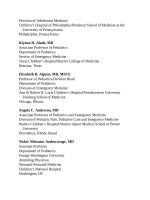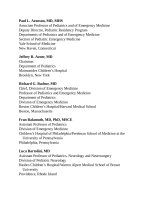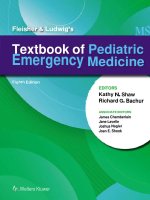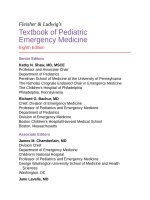Pediatric emergency medicine trisk 0329 0329
Bạn đang xem bản rút gọn của tài liệu. Xem và tải ngay bản đầy đủ của tài liệu tại đây (98.59 KB, 1 trang )
FIGURE 11.8 An example of “Welcome Pamphlet” given to families of transport patients of
The Children’s Hospital of Philadelphia. (Used with permission, © The Children’s Hospital of
Philadelphia, Philadelphia, PA.)
Regardless of their degree of involvement, physicians should be aware of the
air medical transport resources and capacities in their region. Two basic types of
air transport exist: RW helicopter and FW aircraft. RW aircraft are common in
both rural and urban EMS systems, are typically hospital based, and usually carry
a nurse, respiratory therapist, or physician as one (or more) of their crew
members, while some services have a paramedic (EMT-P) as a primary crew
member. The unique capabilities of rapid, direct scene response give the RW craft
a distinct advantage over FW aircraft and ground units in some cases. Helicopter
EMS (HEMS) have allowed for the provision of ALS services to larger rural
areas incapable of sustaining independent ALS units, and have provided access to
tertiary care centers for patients in regions without such centers. In both rural and
crowded metro and suburban areas, RW aircraft offers the benefit of time saved in
transit—a significant benefit in cases such as trauma and surgical emergencies.
However, recent research has suggested that direct air transport from an accident
scene to a trauma center for pediatric patients may not improve survival when
compared with local hospital stabilization prior to air transfer. Moreover,
Engbrecht et al. noted that interfacility transport of patients by RW aircraft was
generally not predictive of need for acute intervention in their study population,









